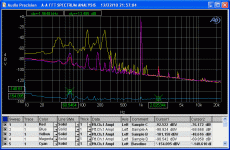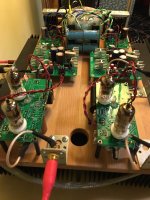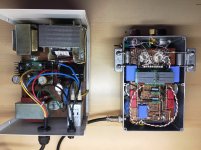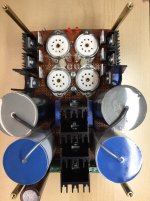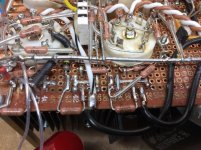Hi what is this FFT software? Have tambien a hardware?
Gracias!
I am using MI (Multi-Instrument). It's very good but a bit expensive. You can achieve similar results with ARTA or SpectraPlus. You could also use REW that it's free, but it is more oriented to loudspeaker measurement. I'm not sure if MI has its own HW, I use an EMU-0404 soundcard.
jackinnj, I have several pairs of D3a and the result is similar in all of them, so I guess we can eliminate the valve from the equation. As for the input signal, I think it's a good idea. I will use a higher input voltage and maybe I can avoid the noise limitations of the test equipment.
Here's a comparison of D3a's
Attachments
Wow, one of those D3a's looks really bad! That behaviour is very different from what I get in my measurements. My measurements show a quite clear flicker noise (1/f). In his article, Stuart mentions that "most D3a that I've checked needed some time to burn in before their grid current stabilized". I'm not sure if he was referring to this type of noise or to what? It would be nice if he could intervene in this discussion to shed some light on the subject (and, by the way, make me a bit happy  ).
).
Yesterday I tested my HMV implementation on my sound system. As my EMT tonearm is in the process of being rebuilt, I used a CD player whose output goes to my iRIAA module (which provides an inverse of the curve and additionally an attenuation of 60dB, thus a signal similar to what would come out of an MC cartidge), then the signal goes to the phono and the preamp. I was able to check that nearly everything was fine, excellent sound, zero detectable hum but... I could perceive the noise very clearly... it's like listening to music with the sound of a torrential rain in the background... So I have to fix this so that the phono is usable.
I know there are real tube experts in this community, please don't be shy.... Any suggestions are welcome.
Yesterday I tested my HMV implementation on my sound system. As my EMT tonearm is in the process of being rebuilt, I used a CD player whose output goes to my iRIAA module (which provides an inverse of the curve and additionally an attenuation of 60dB, thus a signal similar to what would come out of an MC cartidge), then the signal goes to the phono and the preamp. I was able to check that nearly everything was fine, excellent sound, zero detectable hum but... I could perceive the noise very clearly... it's like listening to music with the sound of a torrential rain in the background... So I have to fix this so that the phono is usable.
I know there are real tube experts in this community, please don't be shy.... Any suggestions are welcome.
Last edited:
I have had a similar issue and still do. Here’s the details:
My HMN is designed for me SPU which is 2 ohms.
I have pair of sowter 1480 step-ups. In one channel a ‘white noise’ developed after the first few weeks, after switching tubes from each channel the white noise stayed with the channel. When I switched cartridges to a dl103 which is 40 ohms. The white noise went away. On top of this I had serious microphonics until I put in some isolation and damping. Rubber gaskets around each tube and foam padding - not perfect yet but way better. The sound dampening is on order. Occasionally it breakouts into full on shrill oscillation, - this went away when I changed cartridges. The SPU needed a rebuild for mechanical reasons and be back in a few months.
My current understanding is that the white noise is really a form of oscillation and that the fact that only in one channel is probably related to wiring. Because the SPU is ‘prewired’ and the tone arm is also I don’t see an opportunity to switch the leads to further chase down the issue. The ‘white noise’ may get worse again when I replace the SPU. I’ll let you know, until then I’ll enjoy the dl103 which sounds fantastic with only a little snow in one channel , - if only a little light on the low end. The snow ain’t hum, - hum!
My HMN is designed for me SPU which is 2 ohms.
I have pair of sowter 1480 step-ups. In one channel a ‘white noise’ developed after the first few weeks, after switching tubes from each channel the white noise stayed with the channel. When I switched cartridges to a dl103 which is 40 ohms. The white noise went away. On top of this I had serious microphonics until I put in some isolation and damping. Rubber gaskets around each tube and foam padding - not perfect yet but way better. The sound dampening is on order. Occasionally it breakouts into full on shrill oscillation, - this went away when I changed cartridges. The SPU needed a rebuild for mechanical reasons and be back in a few months.
My current understanding is that the white noise is really a form of oscillation and that the fact that only in one channel is probably related to wiring. Because the SPU is ‘prewired’ and the tone arm is also I don’t see an opportunity to switch the leads to further chase down the issue. The ‘white noise’ may get worse again when I replace the SPU. I’ll let you know, until then I’ll enjoy the dl103 which sounds fantastic with only a little snow in one channel , - if only a little light on the low end. The snow ain’t hum, - hum!
The SPU is a wonderful cartidge but difficult to amplify properly. I own several and the key is usually in the step-up transformer.
When you talk about white noise I assume you mean Johnson or thermal noise (which does indeed have the white noise pattern). Are you sure you have this type of noise? Have you been able to measure it? Johnson noise and flicker noise are not the same thing. Johnson noise is constant at all frequencies (power spectral density = cte) whereas flicker noise increases with decreasing frequency (pink noise pattern). The former has been widely studied and understood while the latter is somewhat more enigmatic.
When you talk about white noise I assume you mean Johnson or thermal noise (which does indeed have the white noise pattern). Are you sure you have this type of noise? Have you been able to measure it? Johnson noise and flicker noise are not the same thing. Johnson noise is constant at all frequencies (power spectral density = cte) whereas flicker noise increases with decreasing frequency (pink noise pattern). The former has been widely studied and understood while the latter is somewhat more enigmatic.
Last edited:
I am not sure what kind of noise it is but am thinking because it is only in one channel that it can be eliminated with some effort. The other channel is completely quiet even with headphones which is encouraging.
The breakout into shrill oscillation only happens now when the case is mechanically disturbed, like tapping on it or moving it. The rubber gaskets on each tube was simple and effective.
As baseline I tried my Pass Pearl One. Which is dead quiet with the sowter 1480 step-ups. So the problem seems to be down stream from the step-ups. Maybe a noisy ccs semiconductor?
The breakout into shrill oscillation only happens now when the case is mechanically disturbed, like tapping on it or moving it. The rubber gaskets on each tube was simple and effective.
As baseline I tried my Pass Pearl One. Which is dead quiet with the sowter 1480 step-ups. So the problem seems to be down stream from the step-ups. Maybe a noisy ccs semiconductor?
Order your pcb at desired manufacturer. I have posted source files
here:
His Master's Noise: A Thoroughly Modern Tube Phono Preamp
and power supply here
His Master's Noise: A Thoroughly Modern Tube Phono Preamp
Gerber files are needed ones.
Regards,
Tibi
hi, I would like to make your pcbs. Is this link correct for the latest versions? is there a list of components? thanks you are very kind to share!
Here is latest power supply version His Master's Noise: A Thoroughly Modern Tube Phono Preamp
One partial BOM is here His Master's Noise: A Thoroughly Modern Tube Phono Preamp
A more exquisite one is here His Master's Noise: A Thoroughly Modern Tube Phono Preamp
Regards,
Tibi
One partial BOM is here His Master's Noise: A Thoroughly Modern Tube Phono Preamp
A more exquisite one is here His Master's Noise: A Thoroughly Modern Tube Phono Preamp
Regards,
Tibi
Last edited by a moderator:
Here's a comparison of D3a's
jackinnj, I have built a jig to test the noise of several of my D3a's. My results are slightly worse than yours, I suspect because your Audio Precision is much better than my measurement equipment. However I have some questions:
- Did you measure the D3a's on the same HMV circuit or did you build one specifically for that task?
- I assume you measured the noise at the anode of the D3a, right?
Last edited:
Every time I finish a new HMN, I'm blown away by his sound.
This time I mounted tubes on the top and other parts on bottom.
I have replaced D3a with 6Z11P. This have lower gain and work very nice with a MM 4.5mV cartridge.
Regards,
Tibi
This time I mounted tubes on the top and other parts on bottom.
I have replaced D3a with 6Z11P. This have lower gain and work very nice with a MM 4.5mV cartridge.
Regards,
Tibi
Attachments
Every time I finish a new HMN, I'm blown away by his sound.
This time I mounted tubes on the top and other parts on bottom.
I have replaced D3a with 6Z11P. This have lower gain and work very nice with a MM 4.5mV cartridge.
Regards,
Tibi
Hi Tibi. Could you please show the output noise of your HMN with D3a tubes? dBV spectrum with input shorted would be fine. Thanks a lot. Francisco
Francisco,
I just finished another HMN. Some pictures here This time I had noise on one channel and I was able to trace down this on DN2540 CCS.
Some DN2540's are very noisy. So far I found three DN2540 with same noisy behaviour.
Regards,
Tibi
I just finished another HMN. Some pictures here This time I had noise on one channel and I was able to trace down this on DN2540 CCS.
Some DN2540's are very noisy. So far I found three DN2540 with same noisy behaviour.
Regards,
Tibi
Excellent work Tibi!Francisco,
I just finished another HMN. Some pictures here This time I had noise on one channel and I was able to trace down this on DN2540 CCS.
Some DN2540's are very noisy. So far I found three DN2540 with same noisy behaviour.
Regards,
Tibi
I have not been able to make any progress on my project for a year now. I am not able to find the cause of the high noise level in my project (there are several measurements that I have shared here in previous posts: https://www.diyaudio.com/community/...-modern-tube-phono-preamp.163570/post-6546735). I don't give up but I'm already a bit desperate... no one has been able to help me to find out where the problem is. I take this opportunity to ask if someone with experience could help me...
Tibi, in order to see what my objective should be it would help me a lot if you could share a noise spectrum measurement of your phono, if possible one at the phono output and another one taken at the anode of the D3a (don't forget to place a capacitor between the anode and the measuring device to eliminate the DC component!), if possible in dBv, to have a clear reference.
Anyone else who can show these measurements would be very grateful for their contribution...
Merry Christmas to all!
Francisco
Francisco,
In my case the noise was coming from one DN2540 and this was happening three times in three different phono's. I suggest you to measure each CCS.
On the next phono I'll take more time and make some measurements, but till then I suugest you to look at CCS's.
Regards & Merry Christmas !
Tibi
In my case the noise was coming from one DN2540 and this was happening three times in three different phono's. I suggest you to measure each CCS.
On the next phono I'll take more time and make some measurements, but till then I suugest you to look at CCS's.
Regards & Merry Christmas !
Tibi
Thanks for your response Tibi. Can you suggest a way to measure the noise of the DN2540 without taking it out of the circuit? It would be a huge hassle for me to remove them from the circuit. I'll send you some pictures to give you an idea... (the last picture shows how the CSS has been implemented)Francisco,
In my case the noise was coming from one DN2540 and this was happening three times in three different phono's. I suggest you to measure each CCS.
On the next phono I'll take more time and make some measurements, but till then I suugest you to look at CCS's.
Regards & Merry Christmas !
Tibi
The reason to make everything so tight is that the phono has to take the original place of the preamp in an EMT930 turntable.
Regards,
Francisco
Attachments
- Home
- General Interest
- diyAudio.com Articles
- His Master's Noise: A Thoroughly Modern Tube Phono Preamp
